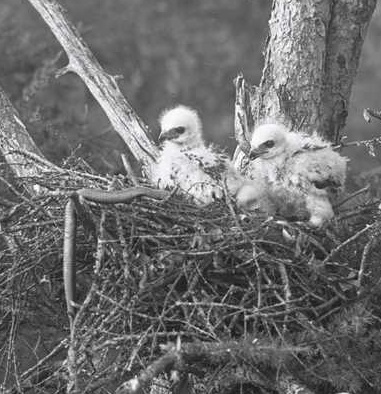One hundred and thirteen years ago at around this time of the year, Thomas Sadler Roberts set out on yet another trip to observe the birds of the state of Minnesota. Roberts kept written records of his ornithological outings in personal journals, and he also captured visual records with his cameras. By consulting both Roberts’s journals and his glass plate negatives preserved in the Bell Museum collection at the University Archives, we can journey back to the last week of June and the first two weeks of July of 1900, to learn that bird “collecting” could be quite cumbersome:
On June 27, 1900 Roberts wrote in his journal, “Left Mpls. At 9 P.M. on Great Northern train for Warren to go on collecting trip to Thief Lake Country.” As was common for Roberts’s trips, Leslie O. Dart accompanied him. Upon their arrival, the two men joined a local man, E.L. Brown, who maintained a “museum” that Roberts described as “a store building filled with mounted birds, mammals and ‘curios’ of all kinds.” A fourth member of the collecting party, Dr. Thos Lee, reached Warren on June 29 and joined the rest of the men in outfitting the farm wagon with supplies that would sustain them for several weeks of camping near Mud and Thief Lakes in Marshall County.
The party departed on June 30, which Roberts documented as a “cloudy, windy threatening day. Cold as a late October day.” The forecast did not improve as they continued their travel. On July 1st Roberts noted that the party encountered a “driving cold rain” after a night of heavy rain and thunder and lightning, yet “found all in wagon dry.” The rain produced muddy roads, which didn’t bode well for wagon travel that day. Roberts described the area they traveled through:
“About 5 P.M. we came onto western edge of what Brown called the Thief River Marshes – a vast sea like expense of meadow and marsh with islands of poplar here and there and farther east toward lake tamarack swamp most of which was dead, only the bare poles standing over large areas forming a scene most desolate. This Brown called typical Moose country.”
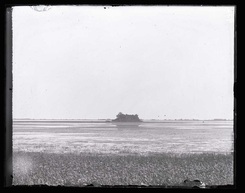
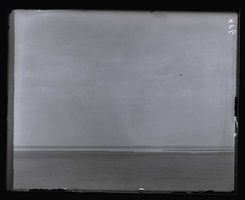
1) View of Mud Lake and Large Island, “Characteristic view of Mud Lake area before drainage. Ideal home of ducks, geese, coots, rails, godwits, grebes and all manner of aquatic fowl.”
2) View of Thief Lake Willows at Mouth of Moose River, “once principal breeding place of Canada geese in Minnesota. Now a waste of weeds.”
The rain continued throughout the day, and the party did not travel as far as they had hoped. On July 2, the weather was still not ideal (“the morning dawned dark, cloudy and threatening and everything all about soaking wet.”). Roberts took the opportunity to explore “Moose country” more closely before the threat of rain again became reality:
“After breakfast I crossed the creek and explored the edge of a tamarack swamp that stretched away toward the west. Found the White-throated Sparrow singing… Labrador Tea & Twin flower Linneae in the swamp with Cranberry, Pyrola [Wintergreen], etc.”
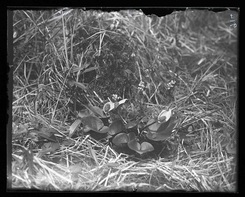
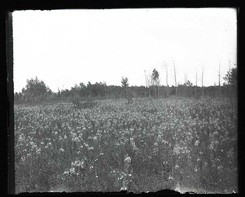
1) Calla and pyrola, Thief Lake
2) Fair weed near Linneae, Thief Lake
“Cleared in the afternoon and Dart and self went back along road… Found the nest of a Traill’s Flycatchers in a willow bush, also nests of Clay-colored Sparrow, King Bird, Martin, etc.”
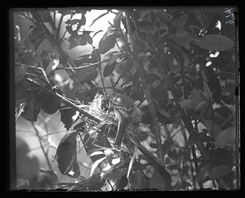
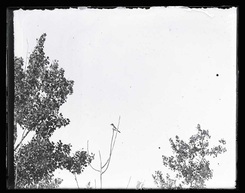
1) Traill’s Flycatcher and nest, Thief Lake
2) King bird on dead branch, Thief Lake
Roberts recorded a physical description of the area where they camped:
“This is the very heart of Moose Country 9 or 10 years ago. Now they [moose] are further east and only occasionally straggle out here. Where we are camped has long been a favorite camping ground for hunters and Indians in the past and the ground is strewn with the bones of bears, moose, etc.”
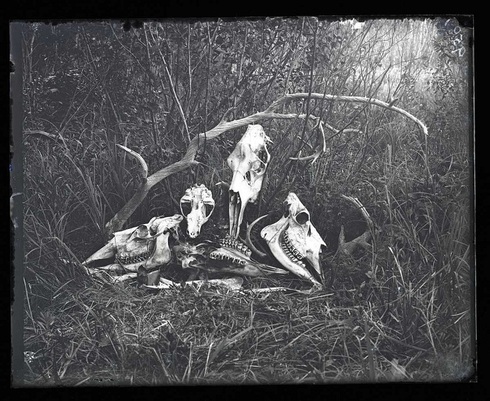
– Moose and bear skulls, Moose River, Marshall County
By July 4 (Independence Day) the weather – and morale – improved. Roberts’s journal entry mentions the national holiday:
“July 4 – Fourth of July in the wilderness. Our friend Brown celebrated by firing off his rifle over the tent before any of us were up and then putting a pack of fire crackers into a kettle sitting them inside the tent filling the whole place with stifling smoke and nearly setting fire to things. It had the effect of getting everybody out. A changeable day but on the whole clear and warm – almost sultry about noon.Lee, Dart, and self spent morning in tamarack swamp. Found nest of Broad-winged Hawk containing three young still in white downy stage. Spent greater part of day rigging our platform in neighboring trees placing camera to try for photograph of old bird on nest. Did not succeed in getting an exposure as she would not return so left….”
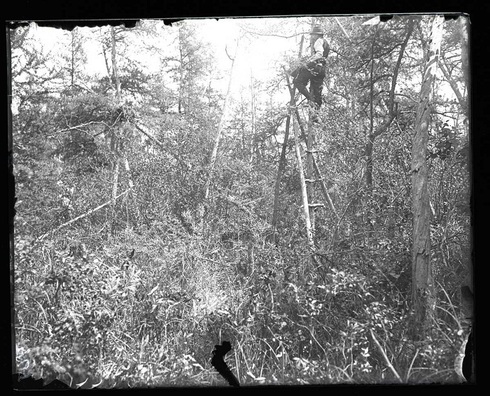
– “Taking” a Broad-winged hawks nest, Thief Lake
Roberts and Dart did not succeed at much else for the next several days, as Roberts’s journal entries reveal that inclement weather continued on July 5, “A raw rainy day and had to stay about camp all day,” July 6, “Rained and blew all day… It was a most disagreeable day and we were all rather discouraged,” and July 7,”Rained hard all day.” Though on July 8, mother nature granted a reprieve, as Roberts recorded, “A beautiful bright day and we are all thankful and much relieved.” That afternoon, Roberts and Dart returned to the platform that they set up four days prior in order to photograph the Broad-winged Hawk. After waiting nearly 2 hours for the hawk to return to the nest, their patience was rewarded, and they “secured two exposures at the nest with the concealed camera.”
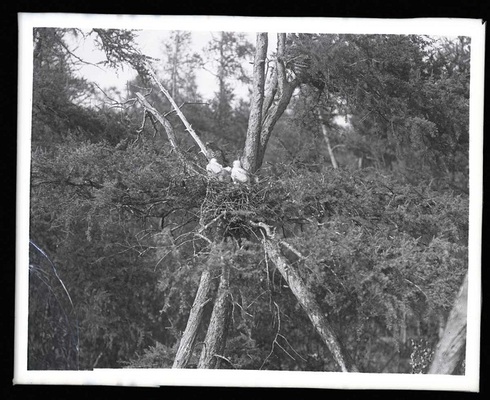
– Broad-winged Hawk, adult and juveniles in nest, Thief Lake
Roberts further described the hawk and it’s young in the nest:
“The young have grown very perceptively since the day we found the nest. They are very restless and spend much of their time tramping about the nest – now up on the edge peering over – now round and round clambering over one another. They make no sound of any kind even when disturbed or when the old bird appears… The old hawk brought on one of her trips a Garter snake – a large female some 15 or 18 inches in length. She left the young to tear it up themselves.”
Roberts and Dart brought the oldest hawk back to their camp and photographed it against a white backdrop:

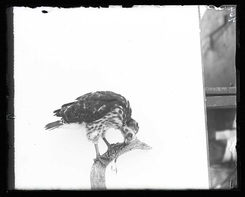
– Broad-winged Hawk, Thief Lake
After multiple days of poor weather, and mild successes in shooting (both gun and camera), Roberts’s cumbersome trip to “Moose country” ended abruptly. An addendum to his journal entry from July 11 indicated, “Was taken sick with an attack of appendicitis and had to go back to Warren and down home. A hard two days trip out to Warren in the springless farm wagon.“
